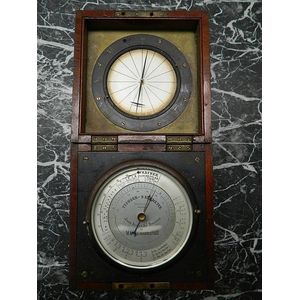Rare Typhoon Barometer with Cyclometer and Wind Disc
You must be a subscriber, and be logged in to view price and dealer details.
Subscribe Now to view actual auction price for this item
When you subscribe, you have the option of setting the currency in which to display prices to $Au, $US, $NZ or Stg.
- Mahogany - Mahogany is a dense, close grained red-coloured timber from the West Indies and Central America. It was first imported into Europe in the the early 18th century and its use continued through the 19th century. It was popular for furniture making because of its strength, the wide boards available, the distinctive grain on some boards, termed flame mahogany and the rich warm colour of the timber when it was polished.. The "flame" was produced where a limb grew out from the trunk of the tree, and this timber was usually sliced into veneers for feature panels on doors, backs and cornices.
Some terms used to describe mahogany relate to the country from which it originally came, such as "Cuban" mahogany, "Honduras" mahogany etc. However unless the wood has been tested the names assigned are more a selling feature, rather than a true indication of the timber's origin. - Bevel / Chamfer - In furniture making, a chamfered corner refers to a technique used to create a smooth, angled edge on the corner of a piece of furniture. This is typically done by cutting away a small portion of the corner at an angle, typically 45 degrees, creating a diagonal edge, rather than a sharp 90-degree angle. This technique can be used on various parts of a piece of furniture such as table legs, drawer fronts, or door frames. Chamfering can add visual interest to a piece and can help to soften the overall look of a piece of furniture. It is often used in conjunction with other techniques, such as rounding edges or using contrasting wood species to create a more elegant, sophisticated look. Chamfering is a simple way to add a touch of elegance to a piece of furniture and it is a common technique used by furniture makers.
- Circa - A Latin term meaning 'about', often used in the antique trade to give an approximate date for the piece, usually considered to be five years on either side of the circa year. Thus, circa 1900 means the piece was made about 1900, probably between 1895 and 1905. The expression is sometimes abbreviated to c.1900.
This item has been included into following indexes:
- barometers, period or origin
- barometers, type
Visually similar items

A good mahogany case 2 day marine chronometer by Edw. Baker, no.1067, in brass bound gimbal fitted case. Up and down with subsidiary seconds dial. Three and three quarter inch silvered dial. Replacement hands. Fusee drive. Ernshaw detent escapement. C.1850

Oak cased bracket clock with striking movemnt

An English Thomas Mercer Ltd. marine chronometer 17313, c.1930, silvered dial with Roman numerals, up and down dial with sub/seconds. Bezel dia 125 mm. Two day with Ernshaw Detent escapement. Gimballed mahogany case with Hong Kong Rate certificate. Ship 'G

Antique black and rouge marble clock, no key, no pendulum, approx 28 cm high
